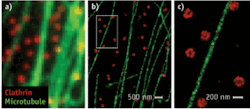FLOW CYTOMETRY, MOLECULAR IMAGING: Cell Bio emphasizes easy access, low volume
Among the papers that the organizers of the Cell Bio show (the American Society for Cell Biology annual meeting, Dec. 13-17, 2008) chose to highlight for journalists covering the event, most emphasized science, not technology. The exception was a presentation by the Harvard University (Cambridge, MA) team that adapted its stochastic optical reconstruction microscopy (STORM) fluorescence technique to provide extraordinarily clear 3-D images of cells’ interiors, laterally resolving features as small as 20 to 30 nm.
Though the event wasn’t anywhere near as large as Neuroscience, proportionally it featured just as many offerings of interest to bio-optics watchers. Exhibitors included companies producing flow cytometers and cell sorters, molecular imaging systems, hyperspectral imaging and microscope systems and other analysis systems. The exhibit hall also featured makers of agents, dyes, and assays, stages and other microscopy tools, cameras, and plenty of light sources and optics.
A theme of the event was enabling broader access to powerful instrumentation. For instance Stratedigm (San Jose, CA) showed off its benchtop modular flow cytometer that gives entry-level buyers access to top-quality systems.
Millipore (Danvers, MA) and its partner Guava Technologies (Hayward, CA) used the event to launch a new award (entry deadline is April 30) to support innovative research using new flow cytometry and antibody detection workflows they are developing. Their benchtop system allows even novice technicians to achieve the same high-quality and high-reliability results as trained cytometry specialists after just an hour with the product. “We’re decentralizing the market for basic questions that just a few years ago were considered complex questions,” said Geoff Crouse, vice president of Life Science Business Unit at Millipore. The system targets projects involving thousands of cells instead of millions of cells.
Accuri Cytometers (Ann Arbor, MI) recently launched a similar awards program, and at the show announced the winner: Heather Newkirk won an Accuri C6 flow cytometer—another benchtop unit—which the company says it designed from the ground up with input from hundreds of researchers. According to Accuri, the C6 also costs less than one-third that of the current market leader.
Noteworthy discoveries
Intellego’s (Irvine, CA) clever CellChip cell sorting system, another solution targeting low-volume applications (3K to 20K cells), attracted much attention. Keynote speaker Roger Tsien (honored with the 2008 Nobel Prize in Chemistry for his discovery and development, in collaboration with two other scientists, of green fluorescent protein) was among the attendees eager for a demonstration.
The platform aims to help scientists separate cells (either individually or by class), and keeps cells alive and healthy so they can expand. Enabling the study of individual cells (including those of “difficult” cell lines), it uses standard microscopy methods, and a pulsed laser system—provided by ESI/New Wave Research—to sort cells of interest from the cultured population. It also enables an increase in sort criteria, allowing sortation based on morphology and fluorescence signature, for example.
Meanwhile, the German firm Nanoscribe promoted “true 3-D laser lithography systems” that allow creation of three-dimensional micro- and nanostructures in various commercially available photoresists. CEO Martin Hermatschweiler described applications including development of structures for specific cell growth studies, tissue engineering, and stem cell differentiation.

Barbara Gefvert | Editor-in-Chief, BioOptics World (2008-2020)
Barbara G. Gefvert has been a science and technology editor and writer since 1987, and served as editor in chief on multiple publications, including Sensors magazine for nearly a decade.
